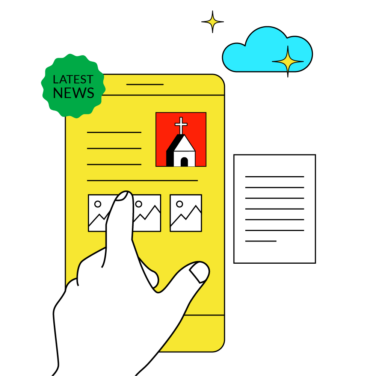Track next steps, not simply attendance: Action shows growth. Headcount alone doesn’t.
Lead with a real story: People respond to testimony more than info dumps.
Only promote what matters widely: If it’s not for 50% of your church, don’t blast it to everyone.
Church communication is NOT marketing—it’s disciple-making. When communication is shallow, scattered, or self-serving, it gets ignored—and worse, it can distract people from the mission.
Here’s what I’ve seen happen when we don’t treat church communication as a disciple-making tool:
- You waste time building emails, slides, and posts no one reads—because they’re not rooted in real action.
- You get constant requests from ministries to “promote this” without any strategy or filter.
- You feel like the church calendar is the boss, and you’re just trying to keep up.
These issues aren’t just annoying—they happen because we treat communication as a series of announcements instead of part of the discipleship pathway.
That’s why this guide exists. These five church communication foundations have helped us move from noise to movement. And throughout it all, one tool keeps everything aligned: your church management software. Think of it as the backbone—helping you track steps, keep teams synced, and turn communication into real-life transformation.
While attendance is an easy metric to track, it doesn't tell the full discipleship story. Be careful about the metrics you use to evaluate your discipleship effectiveness.
Joshua Gordon
Part 1: Define What Success Looks Like
Most churches track attendance because it’s easy. You count heads and report the number. But here’s the problem: attendance tells you who sat in the room—it doesn’t tell you who’s growing, serving, giving, or actually following Jesus.
If your only metric for a successful communications strategy is how many people heard something, you’re aiming way too low.
A healthy church communication strategy is built around action. You’re not just broadcasting updates. You’re inviting people to respond. To take a step. To do something with what they heard. That’s how you measure success—by tracking next steps.
- Did someone join a small group?
- Sign up for baptism?
- Submit a prayer request?
- Start giving regularly?
These are signs of the Great Commission in action, and your church communications should point everything toward that kind of movement.
You’ll be surprised how much clarity this creates, and you don’t necessarily need a church communication platform to do this (though if you have one, use it). Start with a shared spreadsheet. Build a simple form. Talk with ministry leaders about what next steps they want to see, and start keeping track.
When everyone knows what counts as a “win,” you start to get alignment, not just noise.
Part 2: Create a 'Discipleship Pathway'
Most churches send people in too many directions when they challenge their members to take action: "Talk to Pastor Josh to sign-up." "Get on our email list for more information" "Call our office for details" "check the church bulletin", etc...
No wonder folks get lost in the shuffle... and no wonder we feel frustrated and discouraged when sign-ups are lower than we hoped.
When you create one clear, easy-to-remember central destination for folks to take their next step, everything gets simpler (for members, and YOU.)
Joshua Gordon
That central hub can be a single digital destination where people can join a group, register for an event, submit a prayer request, give, or volunteer. When everything happens in one easily accessible place (rather than 5), your administrative burden immediately eases.
But centralizing the platform isn’t enough. You also need to centralize the language. That means training volunteers and staff to communication cohesively. Rather thatn “visit the website” or “talk to someone after service”, give your people the exact phrase every time, something like:
“Go to [yourchurchhub.com] or visit the kiosk in the lobby.”
(or whatever works best for your church's communication)
Repeat that everywhere. Put it in your announcements, slides, emails, print materials. Say it the same way every time. Repetition builds trust. And trust builds momentum.

Part 3: Protect Attention
During promotions or church announcements, you only get so many chances to hold people’s attention—don’t waste them.
Every time you send an email, post on social, or make an announcement, you're making a withdrawal from the attention bank. Too many withdrawals with too little value? People stop listening.
Joshua Gordon
Don't Ignore These Two Rules:
Most churches burn out their channels promoting every single ministry and event equally. But not everything is for everyone. And when you treat it all like it is, people tune out—even the stuff that actually matters.
These two rules will protect that:
- 50% Rule: If it doesn’t apply to at least half your congregation, don’t promote it church-wide.
- The 1-in-5 Rule: Only 1 out of every 5 social media posts or emails should be promotional. The other 4? Serve people. Encourage them. Make them laugh. Point them to Jesus.
More than that, these rules also give your team cover. When someone asks, “Why didn’t my ministry get a stage announcement?”—you’ve got a policy, not just a personal decision. You’re not being difficult. You’re being faithful.
That’s the difference between chaos and clarity.
Part 4: 'Sprint' vs 'Sprinkle' Promo Strategies
Many churches promote in fifth gear all the time... aIf that's your world, you already know what it's like.
- Every event gets a spotlight
- Every Sunday is overloaded
- Every social post is an announcement.
You're constantly sprinting... and, over time, engagement drops and burnout rises. So, I recommend shifting between TWO promotional modes during church communication. These will help you know when to pull back, and when to plan ahead.
Sprint Promotions are rare, focused, all-out campaigns.
Think Easter, Christmas, or a major fall launch. You push hard for 1–2 weeks and take over the bulletin, stage, social, and email with a unified message. That’s a sprint. It costs energy and attention.
You can’t do sprints all the time—but when you do a sprint well, it moves the needle.
Sprinkle Promotions are quieter.
You embed them inside story-driven, helpful content. Think of it like this: 80% encouragement, 20% invitation. You share a volunteer story on Instagram and end with, “You can serve too at [hub link].” Or you tell a baptism story in your newsletter and link the signup form at the bottom. It’s subtle. But it works.
When you use the Sprint vs Sprinkle framework, things get simpler. You’re not saying no to ministry. You’re saying yes on purpose.
Joshua Gordon
Part 5: Root Everything in Discipleship
Church communication isn’t just about getting info about your next church event out—it’s about forming people. That means you don’t start with announcements. You start with stories. You show people what God is doing in real lives, and then you give the hearers a next step to join in.
You’re highlighting a baptism? Don’t lead with the date. Lead with someone’s story. Talk about fear, faith, and what changed. Then end with, “If that’s your next step, sign up today.”
You’re recruiting volunteers? Don’t list the openings. Tell a story of someone who found purpose serving in kids' ministry—and how it changed their faith.
Tell stories, then extend an invitation. Jesus used stories to open hearts - and gave a clear invitation to follow.
He didn’t overwhelm people with logistics. He offered something better—a chance to respond. The goal isn’t more noise. It’s more movement. When you shift from information-first to disciple-first communication, people don’t just listen. They lean in.
Ready to Build a Healthier Church?
If this framework helped you, I send out biweekly resources and real-world encouragement for pastors and church leaders doing the hard, unseen work.
No fluff. Just tools, stories, and strategies to help you lead with clarity and stay faithful in the mess.
Join the list here and get the next issue straight to your inbox.
Because you’re not alone in this—and you don’t have to figure it out by yourself.




